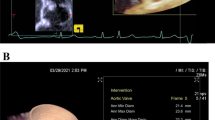Summary
The left main coronary artery was investigated in 30 patients using a transesophageal approach, and a 3D reconstruction of the 2D databases was performed. Two groups of patients were analyzed. First, patients with calcified aortic stenosis were investigated and the reconstructed data obtained were compared to the left ventricular angiogram of the left coronary artery. Second, the 2D databases of patients with non-calcified aortic valve and aortic anulus were reconstructed using the 3D technique. In group 1 the estimate in size of the left ventricular coronary artery was closely related to the diameter of the left coronary artery as obtained by the coronary angiogram (mean difference 0.08 mm, interval of confidence at 95%, –0.48 and +0.32 mm). In both groups a substantial increase in imaging of the left coronary artery was obtained compared to the standard 2D echocardiographic view (+50% in group 1, and +57% in group 2, respectively). Independent of the 3D reconstruction of the left coronary artery in the anyplane mode, an orthogonal imaging of the artery could be obtained in only 15% of patients in group 1 but in 40% of patients in group 2. We conclude that 3D reconstruction of the left coronary artery (LAD) is superior to 2D echocardiography in echo-imaging of the proximal part of the LAD and correlates strongly to the diameters measured in the left coronary angiogram. In patients with major calcification of the aortic anulus and/or a calcified native aortic valve this approach is associated with multiple artifacts in imaging. The rapid technical evolution in this technique including improvement in computer technology and appropriate software may ensure a further important role of 3D echo imaging in non-invasive visualization of the normal and diseased left main coronary artery.
Zusammenfassung
Die linke Koronararterie wurde bei 30 Patienten mittels Ultraschall in transösophagealer Technik untersucht. Der akquirierte 2-dimensionale Datensatz wurde im Anschluss an die Untersuchung 3-dimensional rekonstruiert. Untersucht wurden zwei Patientengruppen. Gruppe 1 bestand aus Patienten, die aufgrund eines verkalkten Aortenvitiums zusätzlich einer Linksherzkatheteruntersuchung unterzogen wurden, Gruppe 2 aus Patienten, bei denen aus anderer Indikation eine transoesphageale Ultraschalluntersuchung durchgeführt wurde. Die durch 3-dimensionale Rekonstruktion erhaltenen Daten zeigen in Gruppe 1 eine sehr gute Übereinstimmung zu den koronarangiographisch gemessenen Durchmessern des linken Koronarostiums (Abweichung im Mittel um 0,08 mm; Konfidenzintervall bei 95% –0,48 und +0,32mm). In beiden Patientengruppen zeigt sich im Vergleich zur konventionellen 2-dimensionalen Echokardiographie ein Zuwachs der einsehbaren Länge der linken Koronararterie um 3,1mm (+50%) in Gruppe 1 und 3,3mm (+57%) in Gruppe 2 im 3-dimensionalen Datensatz. In beiden Gruppen war die Darstellung des Ostiums der linken Koronararterie durch drop-outs im Datensatz oder durch zu geringen Kontrast erheblich erschwert. In Gruppe 1 war die orthogonale Darstellung der linken Koronararterie in Gruppe 1 in 2 von 18 Fällen und in Gruppe 2 hingegen in 4 von 10 Fällen möglich. Die Datenerhebung in Gruppe 1 ist durch verkalkungsbedingte Schallauslöschungen und damit verbundene drop-outs charakterisiert, die eine 3-dimensionale Rekonstruktion der linken Koronararterie in erheblichem Maße erschweren. Wir schließen aus unseren Daten, dass bei Patienten ohne technisch limitierende Verkalkungsstrukturen im Bereich des Aortenringes und der aortalen Taschenklappen sich der Anfangsabschnitt der linken Koronararterie in der überwiegenden Zahl der Patienten durch eine 3-dimensionale Ansicht rekonstruieren lässt.
Similar content being viewed by others
Author information
Authors and Affiliations
Additional information
Eingegangen: 25. Juli 2000 Akzeptiert: 15. Mai 2001
Rights and permissions
About this article
Cite this article
Fischer, T., Menzel, T., Kölsch, B. et al. Quantitative Analyse des Hauptstammes der linken Koronararterie durch 3D-Echokardiographie Stellenwert, Möglichkeiten und Grenzen der nicht-invasiven Darstellung der linken Koronararterie. Z Kardiol 91, 33–39 (2002). https://doi.org/10.1007/s392-002-8369-3
Issue Date:
DOI: https://doi.org/10.1007/s392-002-8369-3




